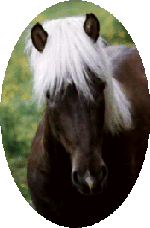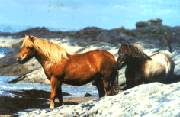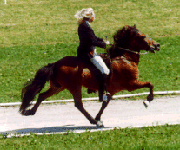 |
The Icelandic Horse |
All of the horses found in Iceland today are the descendants of horses taken there by the Vikings. Space was precious on the longboats, so only the best horses were selected. The ancestors of today´s Icelandic horses came from Northern Scandinavia and the British Isles - in particular the Dole Horse of Norway and from Britain the Celtic Pony, the ancestor of the Exmoor and the Shetland.
In 982AD the Icelandic Parliament passed a law forbidding the importation of any more horses or ponies to prevent disease. As a result, all the horses in Iceland are descended from a relatively small gene pool, but over the centuries ruthless selection - by man and nature - has eradicated the faults that might be expected to occur in such a closely related population. Even today, any horse which leaves Iceland can never return.
| The Icelandic horse is rarely more than 14.2hh, or less than 12hh. He is rather stocky, with a deep chest, expressive head, supple, well-set neck and strong limbs. When ridden, he should give an impression of courage and power, with a proud expression. The mane and tail are thick and plentiful. In the summer the coat is fine and shiny, but in winter the horse grows a long, thick coat with three distinct layers |  |
Icelandics can be literally any colour - bay, brown, chestnut, grey, skewbald, palomino or dun, with hundreds of variations of the usual colours. One much sought-after colour is silver dapple, in which the body of the horse is chocolate brown and the mane and tail are silvery white.
 |
As well as the usual gaits - walk, trot and canter - Icelandics
also have two extra gaits. The "TÖLT", a 4-beat lateral gait also known as running walk. The Tölt can be performed at any speed and is smooth and comfortable for the rider. & The FLYING PACE, a two-beat lateral gait used for racing. Flying Pace makes great demands of both horse and rider, but is spectacular to watch and exhilarating to ride. The horse can reach speeds of 30mph. |
Icelandics should not be backed until they are at least four years old, and they are not considered mature until seven, but they are commonly still in work at 25 or 30 years of age - the oldest one so far in Britain died at the age of 42. They are extremely versatile riding horses, bred to carry heavy adult riders. They have short-coupled legs with very high bone density. Although small, they are always referred to as "horses" - there is no word in Icelandic for pony, and the Icelanders wish to honour their national breed, which holds the title "the most useful servant".
Icelandics are incredibly versatile. As well as being excellent family riding horses, they are used for driving, hunting, long distance and endurance riding, racing, horse football, le TREC, dressage, gymkhana, riding for the disabled, trekking and just about any other equestrain discipline.
 |
To find out more about this fascinating breed please visit the
Icelandic Horse Society of Great Britain website. The information and pictures in this article are provided courtesy of the IHSGB |